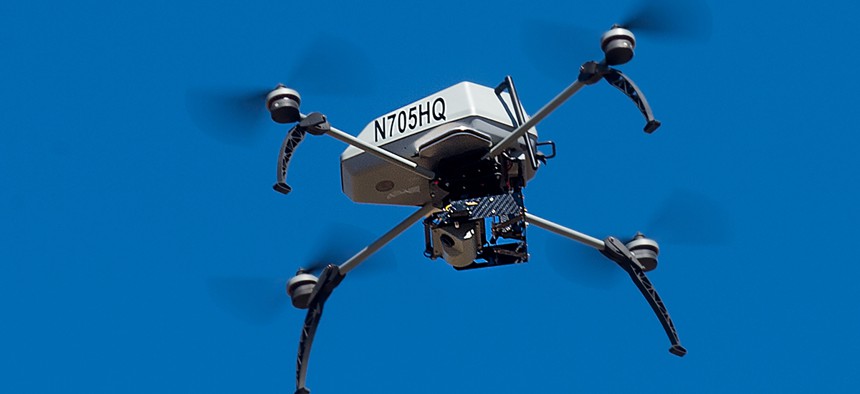Justice Wants Drones to Try Reconstructing Car Crashes

A drone operated by the Alameda County Sheriff's Office flies during a demonstration of a search and rescue operation on Friday, Aug. 14, 2015, in Dublin, Calif. Noah Berger/AP
Police departments in Florida, Kansas and Texas are just a few of the local agencies nationwide authorized to patrol the skies, in certain situations, for public safety.
The Justice Department plans to run drone tests to measure how well unmanned aircraft systems can help reconstruct automobile crashes.
Trials are expected to take place in various jurisdictions across the country.
The National Criminal Justice Research, Test and Evaluation Center on Thursday is scheduled to begin seeking interest from police departments that currently investigate accident scenes using drones.
"The center has identified a number of agencies that have operational UAS capabilities configured to support law enforcement. The center is now seeking to partner with those or other interested agencies in order to complete the operational evaluation," National Institute of Justice Director Nancy Rodriguez said in a pre-publication request for information.
The research likely will start in 2017 and continue until there have been enough motor vehicle accidents to draw data from, an Office of Justice Programs official told Nextgov on background.
Police departments in Florida, Kansas and Texas are just a few of the local agencies nationwide authorized to patrol the skies, in certain situations, for public safety.
There are some concerns that data captured remotely by, essentially flying video cameras, might compromise the privacy of citizens and data reliability.
Among other things, Justice wants to hear about procedures cops have in place for "preserving the integrity of collected data for use as evidence."
» Get the best federal technology news and ideas delivered right to your inbox. Sign up here.
In March, a security researcher demonstrated the ease of hacking a high-end drone thought to be deployed by police departments. The unidentified aircraft model used weak Wi-Fi encryption and an insecure radio connection, according to Wired.
When police use drones, it is key they follow chain of custody rules for evidence, said Jeramie Scott, director of the Electronic Privacy Information Center’s Domestic Surveillance Project.
While the focus of the study is on crash reconstruction, the government also is interested in "information on alternative uses of UAS in law enforcement,” Rodriguez said.
In this case, Scott said it is imperative that police protect against mission creep. There should be public, transparent policies spelling out specific use cases to “ensure law enforcement drones acquired for one purpose,” like crash scene reconstruction, “are not then used for secondary purposes that undermine privacy and civil liberties,” like mass surveillance of the public, he said.
The Justice evaluation also aims to assess potential future applications of unpiloted aircraft systems, Rodriguez said.
Some municipalities, here and abroad, plan on or already are using the unmanned flight systems for search and rescue.
Earlier this year, officers in Warwickshire, England, reportedly spotted a missing person using a drone during the first week of a trial run with the aircraft.
Other jurisdictions have begun authorizing police to use weaponized drones.
In North Dakota, a 2015 bill allowed for nonlethal drone use (i.e. using rubber bullets, tear gas and pepper spray), notes TechRepublic.
The crash reconstruction testing will occur during normal operations or scheduled exercises, depending on the preference of the partnering agency.
Justice also wants input on metrics for gauging the performance of drones used for law enforcement purposes.
Follow-up discussions will take place between department officials and select police forces that respond to the survey.
Other information Justice is seeking: the “number of crash scene reconstructions in the past year using UAS only" and "types of data currently stored in reconstruction records database."
In addition, Justice is interested in the make of the drone each agency is using. The survey asks about the types of UAS sensors available, extra accessories, prices and types of real-time monitoring features.
Comments are due to Justice by Aug. 31.
The American Civil Liberties Union’s stance is that police should not be flying drones until agencies establish a formal privacy policy.
"We don’t have a problem with police use of drones for accident or crime scene photography," said Jay Stanley, ACLU senior policy analyst.
However, he added, “no police use of drones should take place until a department has in place a good overall policy for their use . . . covering, for example, the handling of incidentally collected sensitive data," such as, "where a drone captures people on private property adjacent to an accident scene.”
National Institute of Justice spokesman Chuck Wagner said in an email to Nextgov law enforcement departments already have regulations, and in some cases, there are state laws, which mandate how recorded video and audio is handled.
Newton, Kansas, police reportedly need a search warrant to capture surveillance imagery, unless there is an emergency, like a train derailment involving hazardous materials.
“Video, whether it comes from an in-car camera system, pole camera, body-worn camera … or in this case a UAS, is still treated the same (video is video),” Wagner said.
An ACLU report listing recommendations for government use of drones stresses it is important rules are "not made on the fly by police departments simply by virtue of federal grants."
Justice has tapped the Johns Hopkins University Applied Physics Laboratory to run the crash project and will not provide funding to law enforcement agencies for operating the unmanned aircraft, the official said.






